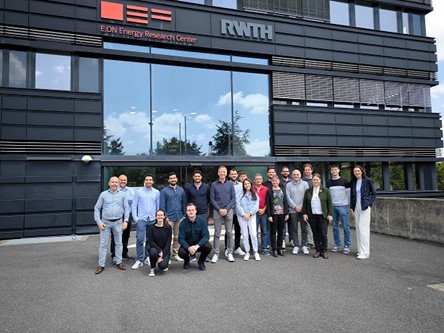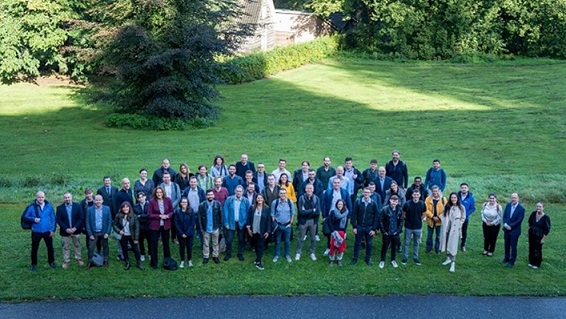THE PROJECT
The project, HEDGE-IoT - "Holistic approach towards Empowerment of the DiGitalization of the Energy ecosystem through adoption of IoT solutions", is founded by the European commission and is composed of 42 partners including large ICT companies, leading RTOs, SMEs, energy stakeholders, EU-level associations and legal & regulatory experts from 13 European countries.
HEDGE-IoT has the objective to "revolutionize energy systems by deploying IoT assets across different levels, from behind-the-meter to the TSO level, and infusion intelligence into the edge and cloud layers using advanced AI/ML tools".
The HEDGE-IoT project, officially launched in January 2024, brings together a consortium of 42 partner organizations from 13 European countries, including leading academic institutions, major energy players, utilities, and technology suppliers.
R&D NESTER's role in the project spans several work packages, notably WP2, which focuses on stakeholders' requirements and system specifications, and WP5, which involves demonstrating technological solutions across various scenarios, particularly in the Portuguese demo.
WORKSHOP
DEFINITION OF THE BUSINESS AND SYSTEM USE CASES (BUCS AND SUCS)
Recently R&D NESTER participated in a workshop organized by RWTH in Aachen, Germany focused on fine-tuning the Business Use Cases (BUCs) and System Use Cases (SUCs) of the HEDGE-IoT project. This initiative, co-funded by the European Union, aims to advance the digitalization of the energy ecosystem through the deployment of IoT solutions across various levels of the energy system, from behind-the-meter to the Transmission System Operator (TSO) level.


The workshop aimed to refine the project's use cases to ensure they effectively address the integration of renewable energy sources, enhance grid resilience, and unlock new flexibility potentials through advanced AI/ML tools and IoT solutions. The project's Business Use-Cases are organized by pilot and listed below:
1. Finnish Pilot
BUC-FI-01: Anomaly detection and fault forecasting to increase Medium Voltage (MV) distribution network resilience
BUC-FI-02: Predictive and real-time congestion management (CM) to increase network hosting capacity
2. Greek Pilot
BUC-GR-01: Flexibility management through active prosumers/consumers engagement
BUC-GR-02: Leveraging data exchange and AI edge algorithms for energy forecasting and prevention of critical grid events
BUC-GR-03: Flexibility trading platform for mitigating problems of the T&D networks
3. Italian Pilot
BUC-IT-01: Energy flow optimisation with dynamic grid limits
BUC-IT-02: Flexibility provided by Energy Community to solve a local congestion
4. Dutch Pilot
BUC-NL-01: Energy Flexibility at business park
BUC-NL-02: Enhance local grid resilience through detection & prevention
5. Portuguese Pilot
BUC-PT-01: GreenVale - Harnessing the potential of energy communities by leveraging Federated Learning strategies
BUC-PT-02: Participation of industrial and residential energy communities in ancillary services market for the TSO
BUC-PT-03: Flexibility aggregation at tertiary buildings
6. Slovenian Pilot
BUC-SI-01: Maximizing asset capacity for increased lifetime of DSO and TSO equipment
BUC-SI-02: Enhanced Network Manageability and Observability
1st PLENARY MEETING
R&D Nester was present in the 1st Plenary Meeting of HEDGE-IoT Project that was held in Arnhem, Netherlands.

In addition to contributing in multiple work packages inside the project, R&D Nester, along with REN, take action in the Portuguese pilot which has the ambition to optimize and facilitate the deployment of grid flexibility services in residential and commercial energy communities located in different geographies of the country. Specifically, R&D Nester's expertise on energy market participation and simulation capabilities will path the way towards a future implementation and adoption of client participation in ancillary services' markets.
R&D Nester's participation leverages on the improvement of an in-house developed energy market simulator. This tool has ability to use historical data from official sources (e.g. ENTSO-E transparency platform) and evaluate the performance of flexibility bids coming from a Residential or Industrial Energy Communities. In the context of the project, a flexibility bid refers to the ability of a load (aggregated or not), and/or distributed energy sources to modify their consumption/generation profile. This action supports the system operator in the maintenance of the power system's reliability and safety.
Ancillary services can generate an additional revenue stream for Residential or Industrial Energy Communities which are willing to participate in the ancillary services markets. Similarly, the project aims to assess the technical readiness of Residential or Industrial Energy Communities for their participation in ancillary services markets, taking into account the technical requirements for its provision.
This participation opens new opportunities for new stakeholders to actively participate in ancillary services market, being a step forward in the democratization of the support to the stability of the electrical power system.
For more details on R&D NESTER's involvement in the HEDGE-IoT project, you can visit the official project page and R&D Nester website.
#HorizonEurope #ClimateAction #EnergyTransition #HEDGE-IoT #RDNESTER
#CreatingSmartEnergyFuture









